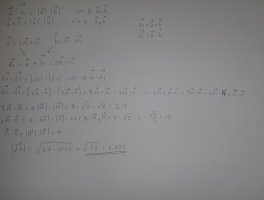Hello everyone, please help me with this task, I can't do it and I would like to understand and do it.
Calculate the lengths of the diagonals of a parallelogram whose sides are a vectors:
[imath]a\vec{} = 2m\vec{} + n\vec{}[/imath]
[imath]b\vec{} = m\vec{} - 2n\vec{}[/imath]
if [imath]|m\vec{}\;|= \sqrt{3}[/imath] , and [imath]|n\vec{}\;|=2[/imath] , and [imath]\angle{\vec{m},\vec{n}} = \pi/6[/imath]
Calculate the lengths of the diagonals of a parallelogram whose sides are a vectors:
[imath]a\vec{} = 2m\vec{} + n\vec{}[/imath]
[imath]b\vec{} = m\vec{} - 2n\vec{}[/imath]
if [imath]|m\vec{}\;|= \sqrt{3}[/imath] , and [imath]|n\vec{}\;|=2[/imath] , and [imath]\angle{\vec{m},\vec{n}} = \pi/6[/imath]




